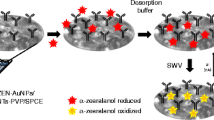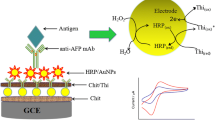Abstract
A novel optical immunosensor for the screening of ampicillin (Amp) residues has been developed. The biosensor is based on fiber optic particle plasmon resonance detection and uses an enhancement method called as fiber optic nanogold-linked immunosorbent assay (FONLISA) for the sensitive detection of antibiotics. A commercial antibody which had a higher affinity for ampicillin than for other β-lactam antibiotics was chosen. A surface competitive binding assay was used in which a fixed concentration of antibiotic-conjugated gold nanoparticles (AuNPs) competes with free unlabeled antibiotic molecules to measure the amount of binding with antibody molecules immobilized on an optical fiber. The synthesis of the 11-mercaptoundecanoic acid (MUA)-ampicillin conjugate facilitates the attachment of the Amp molecules to AuNPs via MUA which acts as a linker between them. This AuNP–Amp conjugate was then used for the detection of β-lactam antibiotics. The practical limit of detection obtained for Amp was 0.74 ppb (7.4 × 10−10 g/mL) which is lower than the recommended maximum residue limit (MRL) for β-lactams. The method also shows a wide linear range of 4 orders. Its applicability to the determination of ampicillin in spiked milk samples has been demonstrated with good recovery and reproducibility.

Graphical abstract








Similar content being viewed by others
Availability of data and material
All data generated or analyzed during this study are included in this published article and its supplementary material file.
References
Rosegrant MW, Fernandez M, Sinha A, et al (2009) Looking into the future for agriculture and AKST. Retrived from https://hdl.handle.net/10568/37336. Accessed 3 Mar 2019
Preston RL (1988) The role of animal drugs in food animal production. Symposium on Animal Drug Use - Dollars and Sense, Washington. pp. 127–133
Silbergeld EK, Graham J, Price LB (2008) Industrial food animal production, antimicrobial resistance, and human health. Annu Rev Public Health 29:151–169. https://doi.org/10.1146/annurev.publhealth.29.020907.090904
Council NR (1980) The effects on human health of subtherapeutic use of antimicrobials in animal feeds. National Academies Press, Washington, D.C.
Landers TF, Cohen B, Wittum TE, Larson EL (2012) A review of antibiotic use in food animals: perspective, policy, and potential. Public Health Rep 127:4–22. https://doi.org/10.1177/003335491212700103
Economou V, Gousia P (2015) Agriculture and food animals as a source of antimicrobial-resistant bacteria. Infect Drug Resist 8:49–61. https://doi.org/10.2147/IDR.S55778
Angulo FJ, Baker NL, Olsen SJ et al (2004) Antimicrobial use in agriculture: controlling the transfer of antimicrobial resistance to humans. In: Seminars in pediatric infectious diseases. Elsevier, In, pp 78–85
Berends BR, van den Bogaard AE, Van Knapen F, Snijders JM (2001) Human health hazards associated with the administration of antimicrobials to slaughter animals. Part II. An assessment of the risks of resistant bacteria in pigs and pork. Vet Q 23:10–21. https://doi.org/10.1080/01652176.2001.9695069
Xie K, Jia L, Xu D, Guo H, Xie X, Huang Y, Chen X, Bao W, Dai G, Wang J (2012) Simultaneous determination of amoxicillin and ampicillin in eggs by reversed-phase high-performance liquid chromatography with fluorescence detection using pre-column derivatization. J Chromatogr Sci 50:620–624. https://doi.org/10.1093/chromsci/bms052
Cháfer-Pericás C, Maquieira A, Puchades R (2010) Fast screening methods to detect antibiotic residues in food samples. Trends Anal Chem 29:1038–1049
Olstege DMH, Uschner BP, Hitehead GW (2002) Screening and mass spectral confirmation of β-lactam antibiotic residues in milk using LC-MS/MS. J Agri Food Chem 50:406–411. https://doi.org/10.1021/jf010994s
Bogialli S, Capitolino V, Curini R, di Corcia A, Nazzari M, Sergi M (2004) Simple and rapid liquid chromatography−tandem mass spectrometry confirmatory assay for determining amoxicillin and ampicillin in bovine tissues and milk. J Agric Food Chem 52:3286–3291. https://doi.org/10.1021/jf0499572
Stolker AAM, Rutgers P, Oosterink E, Lasaroms JJP, Peters RJB, van Rhijn JA, Nielen MWF (2008) Comprehensive screening and quantification of veterinary drugs in milk using UPLC–ToF-MS. Anal Bioanal Chem 391:2309–2322. https://doi.org/10.1007/S00216-008-2168-8
Kantiani L, Farre M (2009) Analytical methodologies for the detection of β-lactam antibiotics in milk and feed samples. Trends Anal Chem 28(6):729–744. https://doi.org/10.1016/j.trac.2009.04.005
Babington R, Matas S, Marco M (2012) Current bioanalytical methods for detection of penicillins. Anal Bioanal Chem 403:1549–1566. https://doi.org/10.1007/s00216-012-5960-4
FitzGerald SP, O’Loan N, McConnell RI et al (2007) Stable competitive enzyme-linked immunosorbent assay kit for rapid measurement of 11 active beta-lactams in milk, tissue, urine, and serum. J AOAC Int 90:334–342
Benito-Peña E, Moreno-Bondi MC, Orellana (2005) Development of a novel and automated fluorescent immunoassay for the analysis of β-lactam antibiotics. J Agri Food Chem 53(17):6635–6642. https://doi.org/10.1021/jf0511502
Gustavsson E, Bjurling P, Sternesjö Å (2002) Biosensor analysis of penicillin G in milk based on the inhibition of carboxypeptidase activity. Anal Chim Acta 468:153–159
Adrian J, Pasche S, Voirin G, Adrian J, Pinacho DG, Font H, Sánchez-Baeza F, Marco MP, Diserens JM, Granier B (2009) Wavelength-interrogated optical biosensor for multi-analyte screening of sulfonamide, fluoroquinolone, β-lactam and tetracycline antibiotics in milk. Trends Anal Chem 28:769–777. https://doi.org/10.1016/J.TRAC.2009.04.011
Gaudin V, Fontaine J, Maris P (2001) Screening of penicillin residues in milk by a surface plasmon resonance-based biosensor assay: comparison of chemical and enzymatic sample pre-treatment. Anal Chim Acta 436:191–198. https://doi.org/10.1016/S0003-2670(01)00948-5
Byzova NA, Zvereva EA, Zherdev AV, Dzantiev BB (2011) Immunochromatographic technique for express determination of ampicillin in milk and dairy products. Appl Biochem Microbiol 47:627–634. https://doi.org/10.1134/S0003683811060032
Cacciatore G, Petz M, Rachid S, Hakenbeck R, Bergwerff AA (2004) Development of an optical biosensor assay for detection of β-lactam antibiotics in milk using the penicillin-binding protein 2x*. Anal Chim Acta 520:105–115. https://doi.org/10.1016/j.aca.2004.06.060
Song K-M, Jeong E, Jeon W, Cho M, Ban C (2012) Aptasensor for ampicillin using gold nanoparticle based dual fluorescence–colorimetric methods. Anal Bioanal Chem 402:2153–2161. https://doi.org/10.1007/s00216-011-5662-3
Karaseva N, Ermolaeva T, Mizaikoff B (2016) Piezoelectric sensors using molecularly imprinted nanospheres for the detection of antibiotics. Sens Actuat B 225:199–208. https://doi.org/10.1016/j.snb.2015.11.045
Puchades R, Cha C (2010) Fast screening methods to detect antibiotic residues in food samples. Trends Anal Chem 29(9):1038–1049. https://doi.org/10.1016/j.trac.2010.06.004
Cheng S-F, Chau L-K (2003) Colloidal gold-modified optical fiber for chemical and biochemical sensing. Anal Chem 75:16–21. https://doi.org/10.1021/ac020310v
Chau L-K, Lin Y-F, Cheng S-F, Lin T-J (2006) Fiber-optic chemical and biochemical probes based on localized surface plasmon resonance. Sens Actuat B 113:100–105. https://doi.org/10.1016/j.snb.2005.02.034
Chiang C-Y, Huang T-T, Wang C-H, Huang CJ, Tsai TH, Yu SN, Chen YT, Hong SW, Hsu CW, Chang TC, Chau LK (2020) Fiber optic nanogold-linked immunosorbent assay for rapid detection of procalcitonin at femtomolar concentration level. Biosens Bioelectron 151:111871
Otte MA, Estévez MC, Regatos D, Lechuga LM, Sepúlveda B (2011) Guiding light in monolayers of sparse and random plasmonic meta-atoms. ACS Nano 5(11):9179–9186. https://doi.org/10.1021/nn203432z
Wu W-T, Chen C-H, Chiang C-Y, Chau L-K (2018) Effect of surface coverage of gold nanoparticles on the refractive index sensitivity in fiber-optic nanoplasmonic sensing. Sensors 18(6):1759. https://doi.org/10.3390/s18061759
Chiang C-Y, Hsieh M-L, Huang K-W, Chau LK, Chang CM, Lyu SR (2010) Fiber-optic particle plasmon resonance sensor for detection of interleukin-1β in synovial fluids. Biosens Bioelectron 26:1036–1042. https://doi.org/10.1016/J.BIOS.2010.08.047
Yeh S-B, Chen C-S, Chen W-Y, Huang C-J (2014) Modification of silicone elastomer with zwitterionic silane for durable antifouling properties. Langmuir 30(38):11386–11393. https://doi.org/10.1021/la502486e
Huang Y-C, Chiang C-Y, Li C-H, Chang TC, Chiang CS, Chau LK, Huang KW, Wu CW, Wang SC, Lyu SR (2013) Quantification of tumor necrosis factor-α and matrix metalloproteinases-3 in synovial fluid by a fiber-optic particle plasmon resonance sensor. Analyst 138:4599–4606. https://doi.org/10.1039/C3AN00276D
Chen W-H, Tseng Y-T, Hsieh S, Liu WC, Hsieh CW, Wu CW, Huang CH, Lin HY, Chen CW, Lin PY, Chau LK (2014) Silanization of solid surfaces via mercaptopropylsilatrane: a new approach of constructing gold colloid monolayers. RSC Adv 4:46527–46535. https://doi.org/10.1039/C4RA05583G
Franchini MC, Bonini BF, Camaggi CM et al (2010) Design and synthesis of novel 3,4-disubstituted pyrazoles for nanomedicine applications against malignant gliomas. Eur J Med Chem 45:2024–2033. https://doi.org/10.1016/j.ejmech.2010.01.014
Aslan K, Pérez-Luna VH (2002) Surface modification of colloidal gold by chemisorption of alkanethiols in the presence of a nonionic surfactant. Langmuir 18:6059–6065. https://doi.org/10.1021/la025795x
Finklea HO, Liu L, Ravenscroft MS, Punturi S (1996) Multiple electron tunneling paths across self-assembled monolayers of alkanethiols with attached ruthenium(II/III) redox centers. J Phys Chem 100(48):18852–18858. https://doi.org/10.1021/JP962831Q
Brevnov DA, Finklea HO (2000) Alternating current voltammetry studies of the effect of melittin on heterogeneous electron transfer across a hybrid bilayer membrane supported on a gold electrode. Langmuir 16(14):5973–5979. https://doi.org/10.1021/la9915217
Hsu W-T, Hsieh W-H, Cheng S-F, Jen CP, Wu CC, Li CH, Lee CY, Li WY, Chau LK, Chiang CY, Lyu SR (2011) Integration of fiber optic-particle plasmon resonance biosensor with microfluidic chip. Anal Chim Acta 697:75–82
Prime KL, Whitesides GM (1991) Self-assembled organic monolayers: model systems for studying adsorption of proteins at surfaces. Science (80):1164–1167
Silin V, Weetall H, Vanderah DJ (1997) SPR studies of the nonspecific adsorption kinetics of human IgG and BSA on gold surfaces modified by self-assembled monolayers (SAMs). J Colloid Interface Sci 185:94–103
Liu X, Atwater M, Wang J, Huo Q (2007) Extinction coefficient of gold nanoparticles with different sizes and different capping ligands. Colloids Surf B 58:3–7. https://doi.org/10.1016/j.colsurfb.2006.08.005
Elmes RBP, Orange KN, Cloonan SM, Williams DC, Gunnlaugsson T (2011) Luminescent ruthenium(II) polypyridyl functionalized gold nanoparticles: their DNA binding abilities and application as cellular imaging agents. J Am Chem Soc 133:15862–15865. https://doi.org/10.1021/ja2061159
Weisbecker CS, Merritt MV, Whitesides GM (1996) Molecular self-assembly of aliphatic thiols on gold colloids. Langmuir 12:3763–3772
Alkilany AM, Abulateefeh SR, Mills KK, Bani Yaseen AI, Hamaly MA, Alkhatib HS, Aiedeh KM, Stone JW (2014) Colloidal stability of citrate and mercaptoacetic acid capped gold nanoparticles upon lyophilization: effect of capping ligand attachment and type of cryoprotectants. Langmuir 30:13799–13808
Guliy OI, Zaitsev BD, Smirnov AV, Karavaeva OA, Borodina IA (2019) Sensor for ampicillin based on a microwave electrodynamic resonator. Biosens Bioelectron 130:95–102 S0956566319300533
Gamella M, Campuzano S, Conzuelo F, Esteban-Torres M, de las Rivas B, Reviejo AJ, Muñoz R, Pingarrón JM (2013) An amperometric affinity penicillin-binding protein magnetosensor for the detection of β-lactam antibiotics in milk. Analyst 138:2013–2022
Horwitz W (1982) Evaluation of analytical methods used for regulation of foods and drugs. Anal Chem 54:67–76
Sadler WA (2008) Imprecision profiling. Clin Biochem Rev 29(Suppl 1):S33–S36
Acknowledgments
We thank Prof. Bor-Cherng Hong for helpful advice on the synthesis and characterization of Amp–MUA conjugate.
Funding
This work was supported by the Ministry of Science and Technology of Taiwan (Grant no. MOST 105-2113-M-194-009-MY3) and Center for Nano Bio-Detection from the Featured Research Areas College Development Plan of National Chung Cheng University.
Author information
Authors and Affiliations
Contributions
Conceptualization, Lai-Kwan Chau; methodology, Lai-Kwan Chau and Yuh-Ling Chen; resources, Chun-Jen Huang; investigation, Pallavi Chaudhari and Yen-Ta Tseng; formal analysis, Pallavi Chaudhari, Lai-Kwan Chau, and Yen-Ta Tseng; writing - original draft, Pallavi Chaudhari; writing - review and editing, Lai-Kwan Chau; funding acquisition, Lai-Kwan Chau.
Corresponding author
Ethics declarations
Conflict of interest
The authors declare that they have no conflict of interest.
Code availability
Not applicable
Additional information
Publisher’s note
Springer Nature remains neutral with regard to jurisdictional claims in published maps and institutional affiliations.
Electronic supplementary material
Sensorgram of nonspecific adsorption test by direct assay, sensorgram and calibration graph by direct assay, TEM image and UV-vis spectra of the prepared AuNPs, FTIR spectra of Amp and the synthesized Amp-MUA conjugate, calibration graph for quantitation of IgG on fiber surface, and sensorgram for ampicillin detection at concentration near practical LOQ by FONLISA are provided as supplementary information.
ESM 1
(DOCX 29.2 MB)
Rights and permissions
About this article
Cite this article
Chaudhari, P.P., Chau, LK., Tseng, YT. et al. A fiber optic nanoplasmonic biosensor for the sensitive detection of ampicillin and its analogs. Microchim Acta 187, 396 (2020). https://doi.org/10.1007/s00604-020-04381-w
Received:
Accepted:
Published:
DOI: https://doi.org/10.1007/s00604-020-04381-w




